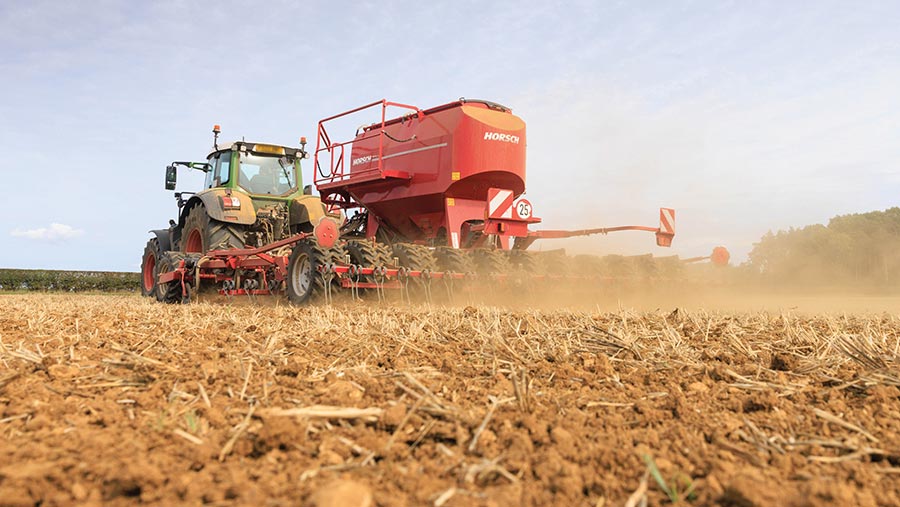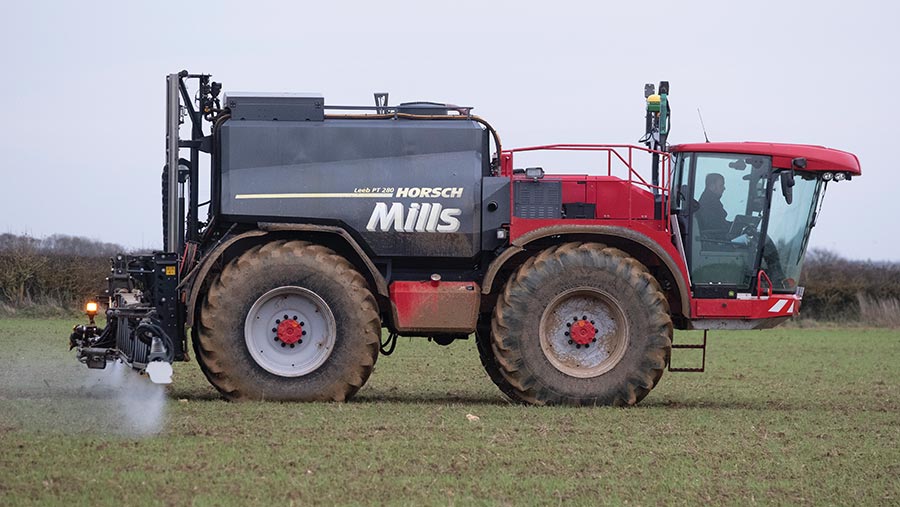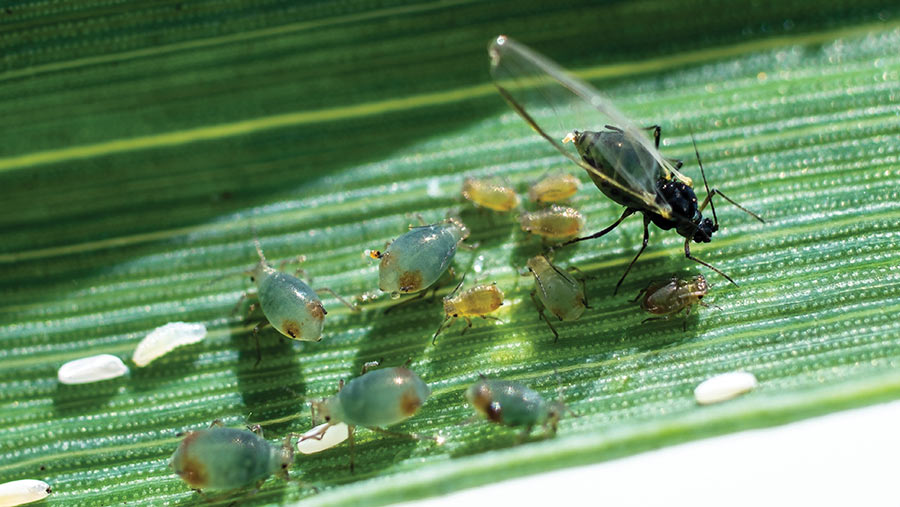Why wheat drill dates should be delayed this autumn
 © Tim Scrivener
© Tim Scrivener Independent agronomists say early wheat drilling compounded many of the yield-limiting issues experienced this year and urge growers to consider the risks when planning planting schedules this autumn.
Back in September 2022, wheat producers were on edge – harvest finished early, very expensive fertiliser was sat in the shed, the wheat price was riding high at £350/t and conditions were suitable for drilling.
See also: Why blackgrass is so bad in 2023 and what to do about it
Some commentators championed early drilling, perhaps encouraged by a promising new grassweed herbicide and decent trials performance of the two newest cereal fungicide additions in recent seasons.
Fast forward to the ongoing harvest and the talk is of average or slightly below average yields, dragged down by a host of problems that in many cases were exacerbated by earlier drilling.
Association of Independent Crop Consultants (AICC) director Matthew Paterson, who advises in the East, reports the highest levels of uncontrolled grassweeds in crops for several years.
He points out that on many farms, drill capacity is stretched and rainfall is tending to fall in extreme events rather than steadily across each month, which is changing the psychology of growers.
“There is a great fear of not getting anything in, so in a year like we’ve just had, when there was a long gap between harvest and drilling, it leans farms towards earlier drilling.”
AICC chairman Andrew Blazey believes that on average, wheat was drilled about 10 to 14 days earlier (late September/early October) than the established post-blackgrass norm (mid-October) across his eastern area.
This also ratcheted up early septoria pressure to levels more akin to those experienced in the South West.
“It forced us to consider a T1.5 fungicide [targeting final leaf 2], but there is a question mark over whether growers can get that on, as sprayer capacity is already stretched.
“There is also the risk of compromising T2 timing, so it’s a bit of a double-edged sword.”
With barley yellow dwarf virus (BYDV) infection at its highest level for several years, Andrew questions whether cover crops are making matters worse.
Although there are many benefits, moving towards having green cover between crops as much as possible can provide a green bridge for BYDV vectors.
There is also an overreliance on pyrethroid sprays to control the disease, with some using two or three in autumns such as 2022. This has a negative impact on beneficial insects that are there to suppress aphid numbers.
“There was a compound effect of earlier drilling on all these problems – there is a need for everyone to remember the risks as we plan for the season ahead,” Andrew notes.
Experts reinforce case for later drilling
Grassweeds
Niab’s grassweed guru John Cussans says the high grassweed pressure in crops this summer can’t be solely attributed to earlier drilling dates, but holding one’s nerve in any autumn is a good foundation for successful control.
The perfect storm of dry conditions, lack of a chit to create stale seed-beds and poor herbicide performance resulted in significant levels of blackgrass in crops.
“We’ve relearned that it doesn’t matter how much money you spend on herbicides, if you get conditions like some of the earliest drilled crops were drilled into – open, dry seed-beds, bright and sunny weather – you can’t get them to work very well at all.
“Some herbicides were less bad than others, but we’re also reminded that the key driver of herbicide efficacy is conditions, more than the herbicides you choose to use.”
Levels of ryegrass continue to rise, with significantly more samples now sent to Niab for resistance testing than other species, and bromes have also been widespread and seen in unexpected places.

Barren and meadow brome heads © Blackthorn Arable
John attributes brome issues to system change, with great and sterile brome in particular encouraged by increasingly common min- or no-tillage regimes.
Also, due to resistance in blackgrass populations, there is now less routine use of post-emergence acetolactate synthase (ALS)-inhibitor herbicides with activity on brome species.
With high weed seed return likely this autumn, John stresses the value of identifying the problem by mapping affected areas and warns many fields will not be suitable for autumn drilling this year.
Where fields are suitable, planting schedules should be planned to start with the cleanest fields and finish with the moderate and higher risk situations, ideally about mid-October onwards.
With wetter conditions prevailing through July, there should be an opportunity to create stale seed-beds after the combine this autumn but, if soils do dry out, the advice is to wait for moisture before moving soil.
“Attempting stale seed-beds in dry conditions is counterproductive: you are better off just leaving weed seeds on top to be degraded by environmental conditions.”
Exceptions are sterile and great brome, which are best worked into the soil with a cultivator behind the combine to help break dormancy.
Meadow and rye bromes are the opposite, best left on the surface as exposed as possible – baling and removing straw helps.
Where bromes have appeared in unexpectedly high numbers, John recommends a review of herbicide programmes.
“Ask yourself where the strengths and weaknesses are. Avadex (tri-allate) and pendimethalin are strong on bromes and bringing back ALS chemistry might help.”
John concludes that 2023 highlighted the importance of good-quality advice on-farm.
“A good agronomist can provide attention to detail, getting out and observing what’s going on and reacting. You can plan, but sometimes you need to adapt and that’s where we saw the best results last year.”
Septoria
Fewer harsh winters mean septoria is now the major disease challenge across the whole UK.
Knowing how drill date affects a variety’s resistance scores, as it did in 2023, is now the key to control.
That’s according to Niab senior crop protection and IPM specialist Aoife O’Driscoll, who points to evidence in the AHDB’s Project Report No. 634 quantifying this effect in simple terms.
It shows that early sowing (average date of 22 September) decreases the effective varietal septoria resistance rating by 0.6 compared with the average of the Recommended List ratings (average sowing date of 7 October).
Late sowing (average date 20 October) is predicted to increase the effective resistance rating by 0.6, for the varietal resistance ratings tested in the project.
Delaying drilling by four weeks from 22 September to 20 October therefore increased the resistance rating of a variety by about 1.2.
The analysis – led by Adas and in collaboration with Niab and SRUC – provides an estimated effect of early or late sowing on septoria disease risk on a scale that is familiar to growers and can be used to support variety selection and management decisions.
With some 30% of the British wheat area down to varieties with a septoria resistance score of 6 or below, some drilled slightly earlier in autumn 2022 would have been very vulnerable to the disease.
“We had such a high spore loading on leaves in spring and it’s whether or not the variety was able resist that. Drilling later will certainly help reduce that pressure and avoid the fungicides having to do so much heavy lifting,” adds Aoife.
BYDV

Spraying winter cereals © Tim Scrivener
Alan Dewar, entomologist, and director of Dewar Crop Protection, says the most obvious way to prevent BYDV epidemics becoming more commonplace is later drilling.
“It reduces the need for pyrethroid sprays in most years and as many farms are trying to control grassweeds, there are other good reasons to do it as well.
“The downside is being caught by inclement weather, like in autumn 2019. It’s not something that everyone can do, so BYDV-tolerant varieties seem like the best way forward.”
Breeder RAGT is leading the way in wheat with Wolverine and Grouse, which was launched this summer.
It also has a potential Group 1 or 2 milling wheat with BYDV tolerance, called Goldfinch, which has just completed National Listing and produced some excellent baking test results.
KWS offers conventional six-row winter barley Feeris, which made the 2022/23 Recommended List.
Such varieties are garnering plenty of interest from those considering the insecticide-free Sustainable Farming Incentive (SFI) option.
However, until BYDV tolerance is incorporated into wheats with complete agronomic packages – as seen with turnip yellows virus tolerance in oilseed rape – there will still be a need to use insecticides in risky seasons.
Alan says better information on when and where to spray is needed.
An improved decision-support landscape would include information on the resistance status of the two main aphid vectors, the grain aphid (Sitobion avenae) and bird cherry-oat aphid (Rhopalosiphum padae).
While resistance to pyrethroids has not yet been found in bird cherry-oat aphids in the UK, grain aphids do carry knock down resistance (Kdr) although there have not been any reported control failures for the past two years.
“With the Kdr gene expressing moderate resistance, it’s only likely to cause a major problem where pyrethroid rates are reduced or spray coverage is poor,” says Alan.
Another important piece of the puzzle is establishing the proportion of aphids carrying BYDV.

Bird cherry-oat aphids © Blackthorn Arable
An AHDB pilot study carried out by Rothamsted in 2018 testing suction trap samples suggested one in five bird cherry-oat aphids were carrying at least one strain of the BYDV virus at some locations.
In subsequent surveys in 2019 and 2022, infectiousness of aphids ranged from 13-34% with 28-58% of them carrying the more severe RPV strain.
Alan believes this is symptomatic of a warming climate allowing the bird cherry-oat aphid to overwinter in grasses and cereal crops as asexuals, rather than developing sexual forms that return to the primary host to reproduce and lay eggs over the winter.
Further work at Rothamsted suggests the proportion of bird cherry-oat aphids colonising cereal crops in the autumn is directly correlated to the severity of the previous winter’s temperature.
While untested in the field, this relationship has potential to be used as part of a risk-prediction tool.
Using suction trap and meteorological data, Alan predicts that some 13% of the population will be cereal colonisers in East Anglia this coming autumn.
Combining this with the pyrethroid resistance data and BYDV status, and other data from suction and yellow water traps and T-Sum calculations, the accuracy of risk forecasting to help insecticide recommendations can be immensely improved.
“However, if we can use new tolerant varieties to stop the yield loss from BYDV, then we wouldn’t have to use insecticides at all,” Alan adds.
Final word – mindset shift needed to make later drilling work in most years
AICC president and Niab northern regional agronomist Patrick Stephenson backs later wheat drilling to ease some of the downward agronomic pressures on winter wheat yields.
However, in his part of Yorkshire it is often very difficult to achieve without significant risk, as the weather can slam drilling windows shut during the first half of October.
This does not mean it’s impossible, but Patrick says a significant shift in mindset is required in the way farms and their staff plan drilling campaigns.
Instead of one operator struggling through a 16-hour shifts, two men could do an eight-hour shift each to maintain standards and keep machinery running.
While some operators will be resistant to losing overtime, businesses could find other extra work and there are positives for the operator such as spending more time with family, which are often not considered.
“Hot-bedding the machinery to do more work in less time ensures the capacity is there to get the job done right in a tighter window, reducing the risk of getting caught out and seed left in the shed.”
All information in this article was gathered at the AICC’s annual summer technical event, which was held at Niab’s Park Farm and Sophi Taylor Building, Histon, near Cambridge in July.

